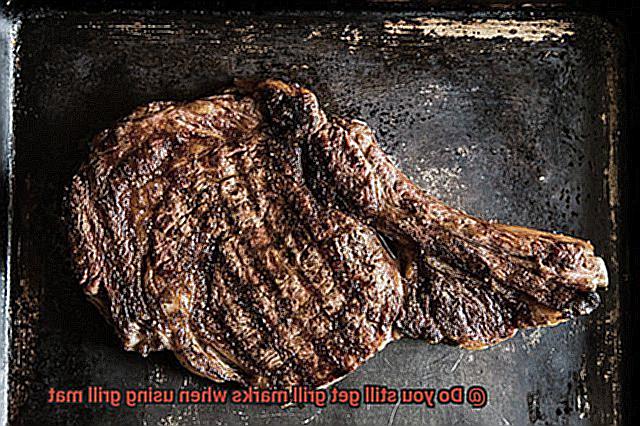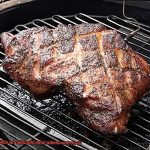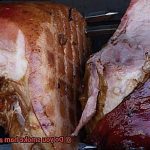Summer is the season for grilling, but nothing beats the anxiety of flipping over your fish fillet without seeing those mouthwatering char marks. Those classic grill marks not only add flavor but also elevate the presentation of your food. If you’re wondering whether a grill mat can replace the beloved char marks, then you’re not alone. Grill mats are perfect for grilling cheese or small vegetables that tend to fall through the grates, but do they still give you those coveted grill marks?
Many people swear that using a grill mat is a recipe for disaster when it comes to achieving those aesthetically pleasing grill marks. They claim that their food comes out soggy and unappetizing, or that using a grill mat is too similar to cooking on a pan, which doesn’t provide grill marks. However, before you dismiss grill mats altogether, let’s debunk this myth together.
In this article, we’ll dive deep into the world of grill mats and answer the burning question: can they create those sexy char marks on your meat or veggies? We’ll also share some insider tips and tricks on how to achieve that perfect sear when using a grill mat. So get ready to become a pro at grilling with a mat.
Contents
What is a Grill Mat?
Grilling is a beloved activity that brings people together, but it can also be frustrating when food sticks to the grates or falls through the gaps. That’s where a grill mat comes in handy. A grill mat is a non-stick mat made of heat-resistant materials, such as PTFE or silicone, that are placed on top of the grill grates. It acts as a barrier between the food and the grates, preventing sticking and making grilling easier and more efficient.
Grill mats come in various sizes and shapes to fit different types of grills, such as gas, charcoal, or electric. They are easy to clean and can be reused many times. Plus, they provide several benefits that make them a go-to tool for any grilling enthusiast.
One of the primary advantages of using a grill mat is that it prevents food from falling through the gaps in the grill grates. This means you can grill smaller or delicate foods like fish, vegetables, or shrimp without worrying about them falling apart or sticking to the grates. Grill mats also allow you to cook foods that are marinated or have a high sugar content without burning them.
But what about those coveted grill marks? Fear not. With some adjustments to your grilling techniques, you can still achieve those beautiful marks even when using a grill mat. The key is to ensure your mat is clean and well-oiled before placing the food on it. You should also lower the temperature slightly to prevent burning or sticking while giving yourself more time to achieve those marks. And resist the urge to flip or move the food too often, as this can disrupt the searing process.
Another advantage of using a grill mat is that it makes cleaning up after grilling much easier. Instead of having to scrub the grill grates with a brush, you can simply wipe down the grill mat with a damp cloth or put it in the dishwasher.
Clean and Oil the Grill Grates for Grill Marks
Grilling is more than just cooking food; it’s an art form. There’s nothing more satisfying than seeing those perfect grill marks on your steak or burger, but did you know that achieving them requires clean and oiled grill grates?
The cleanliness and oiling of your grill grates are crucial for creating the crispy and even grill marks that we all love. So, let’s dive into the steps for cleaning and oiling your grill grates to ensure you get those perfect grill marks every time.
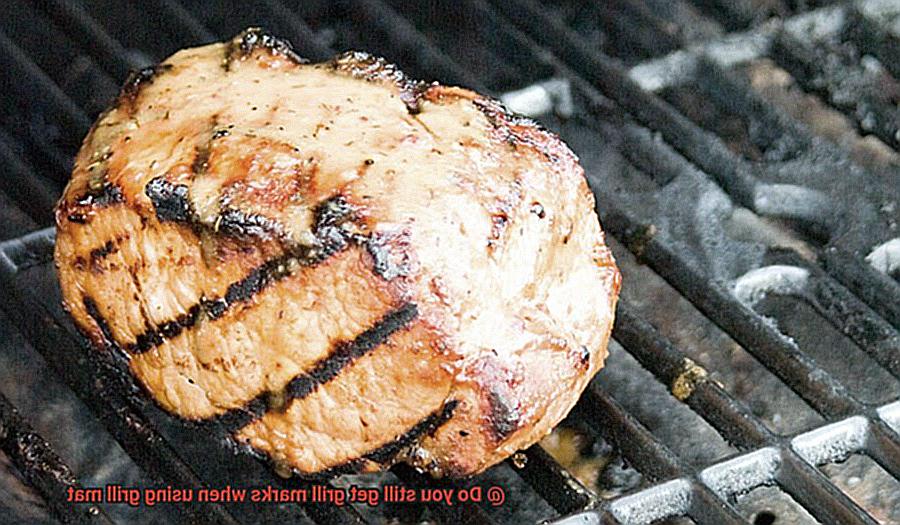
Step 1: Preheat Your Grill
Before cleaning your grill grates, preheat your grill on high for 10-15 minutes. This step will loosen any stuck-on food debris, making it easier to clean.
Step 2: Scrub Away Debris
Using a wire brush or scraper, remove any remaining debris and charred bits from your grill grates. Leftover food particles can prevent heat from reaching the food evenly, resulting in uneven or non-existent grill marks.
Step 3: Oil Your Grates
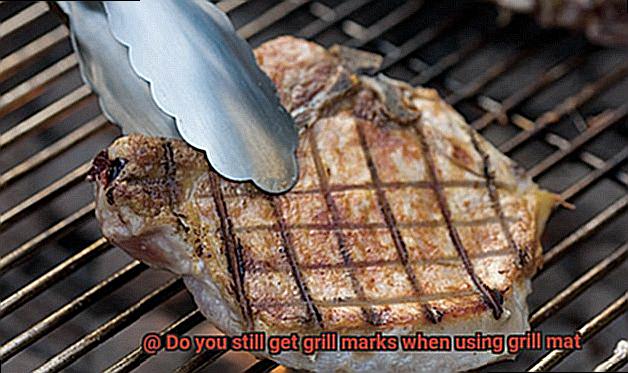
To prevent sticking and ensure even heat distribution, add a coating of oil to your clean grill grates. You can use a high-heat cooking oil like canola or grapeseed oil, or use a non-stick cooking spray designed specifically for grilling.
To oil your grates, dip a folded paper towel into the oil and use tongs to rub it over the grates. Cover all sides of the grates, including any corners or edges.
With clean and oiled grill grates, you can achieve those perfect grill marks every time you fire up the grill. Whether you’re using a grill mat or not, proper cooking techniques such as preheating your mat and adjusting cooking times are necessary.
Brush the Grill Mat with Oil
Grilling is an art form that requires the right tools and techniques to achieve mouth-watering results. One such tool that can revolutionize your outdoor cooking experience is a grill mat. However, before you start grilling, it’s crucial to know how to properly brush the grill mat with oil to maximize its benefits.
Start by ensuring that your grill mat is clean and dry. Any debris or moisture on the mat can hinder the oil’s ability to coat the surface evenly. Once you have a pristine mat, choose an oil with a high smoke point like vegetable or canola oil to avoid any unpleasant flavors.
Now comes the fun part – brushing the grill mat with oil. Use a brush or paper towel to apply a thin, even layer of oil to the mat’s surface. Be careful not to go overboard with the oil as this can lead to flare-ups and make your food oily. Just a light coating is all you need.
After brushing the grill mat with oil, preheat your grill to your desired temperature and place the mat on the grates. Allow it to heat up for a few minutes before adding your food. This will ensure even heat distribution and prevent sticking.
Once you’re ready to cook, place your food on the mat and cook as you normally would. While using a grill mat may not produce as pronounced grill marks as cooking directly on the grates, brushing it with oil can certainly help create those sought-after lines and add some visual appeal to your dishes.
It’s important to note that grill mats tend to produce lighter, more subtle marks on your food than traditional grilling methods. However, if you’re simply looking to add some texture and visual interest to your grilled dishes, brushing the mat with oil is definitely worth trying.
Lower the Heat to Prevent Burning or Sticking
Grilling outdoors is a beloved pastime for many, and using a grill mat can take your grilling game to the next level. However, to achieve the best results, it’s essential to keep the heat in check. In this article, we’ll explore why lowering the heat is crucial when grilling with a grill mat and how to do it right.
The high temperature in the grill can cause the grill mat to burn or stick to your food, making it less than ideal for grilling. To prevent this, lowering the heat is essential. Not only does this ensure that your food cooks evenly, but it also retains its juiciness and tenderness.
So, how much should you lower the heat? To prevent burning or sticking, we suggest reducing the grill’s temperature by about 25 degrees or so. This may require some experimentation based on your grill and the type of food you’re cooking. Different foods require different cooking temperatures; for instance, delicate fish fillets may need a lower heat setting than thick cuts of steak. Therefore, adjusting the heat based on what you’re cooking is vital.
Lowering the heat doesn’t mean sacrificing those beautiful grill marks either. With the right temperature and a little patience, you can still achieve restaurant-quality sear marks on your meats and vegetables.
To sum up, here are some key points to keep in mind when using a grill mat:
- Lowering the heat is crucial to prevent burning or sticking.
- Reduce the grill’s temperature by about 25 degrees or adjust accordingly based on what you’re cooking.
- Different foods require different cooking temperatures.
- Patience is key when achieving those perfect grill marks.
Resist the Urge to Flip or Move Food Too Often
Grilling is more than just cooking food; it’s an art that requires finesse, patience, and experience. However, if you’re using a grill mat, it’s essential to resist the urge to constantly flip or move your food around, as this can hinder achieving those coveted grill marks that make your guests drool.
Grill marks are the holy grail of outdoor cooking. They are the visual cue that tells your guests that you’re a grilling pro. Unfortunately, grill mats can get in the way of creating these perfect charred lines by blocking direct contact between the grates and the food. To overcome this obstacle and achieve those beautiful grill marks, it’s crucial to give your food enough time to sear undisturbed on one side before flipping it over.
In addition to not moving your food too much, preheating your grill before placing the grill mat on top is also vital. A well-preheated grill ensures that the heat is evenly distributed, allowing for even cooking and those perfect sear marks.
To clean the grates before placing a grill mat on top, use a grill brush to remove any debris or residue that may interfere with the cooking process. This step ensures that your food comes out looking and tasting its best.
Overall, using a grill mat may require some adjustments to your grilling technique, but with patience and proper technique, it’s still possible to achieve those coveted grill marks. So resist the urge to flip or move your food around too often when using a grill mat and let that heat do its magic. Remember these tips:
- Don’t flip or move the food around too much
- Preheat the grill before placing the grill mat on top
- Clean the grates before placing the grill mat on top
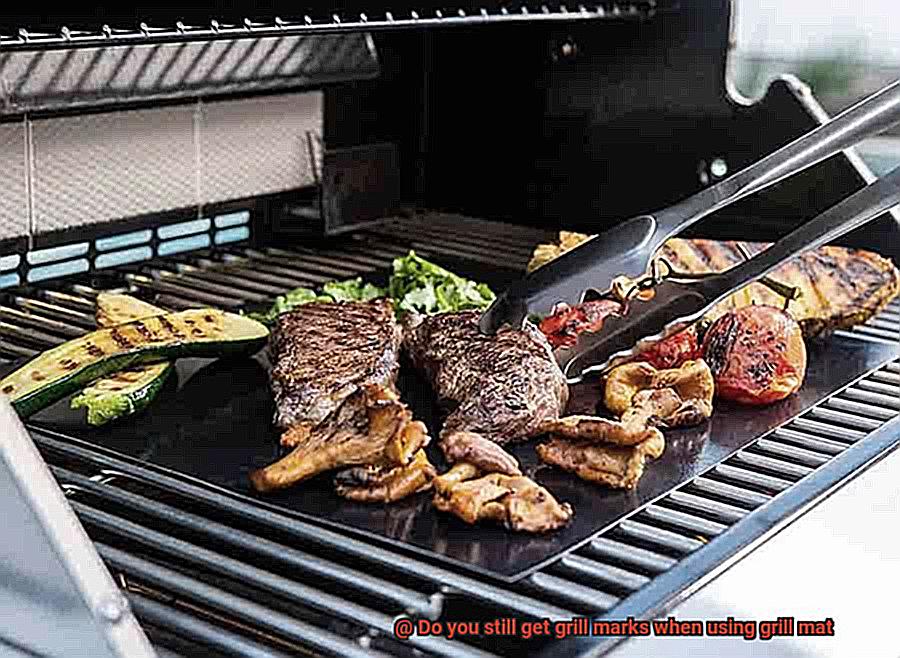
Choose the Right Type of Grill Mat
Grilling is an art form, and nothing beats the satisfaction of seeing those perfect grill marks on your food. However, achieving those coveted char marks can be a challenge when using a grill mat. Fear not, because with the right type of grill mat, you can still achieve those beautiful marks on your steak, chicken or vegetables.
So, what factors should you consider when choosing the right type of grill mat for achieving those grill marks? Firstly, it’s crucial to ensure that the mat is made from high-temperature materials such as PTFE or silicone, which can handle temperatures up to 500-600 degrees Fahrenheit. That way, you’ll be able to cook at high temperatures for extended periods without damaging your grill mat.
Another essential factor to consider is the thickness of the mat. Thicker mats may provide better heat distribution and more even cooking, but thinner mats may give you better grill marks. It’s essential to find a balance between thickness and grill mark formation to achieve the perfect balance of even cooking and striking grill marks.
Finally, pay attention to the design of the mat. Some mats have raised ridges or grooves that can help create those signature grill marks on your food. Others may have a smooth surface that doesn’t leave as strong of a mark. The design ultimately depends on personal preference and what works best for your grilling needs.
Non-stick Mats Work Best for Seared Grilled Marks
Or maybe you’re looking for a way to achieve those beautiful seared grill marks without the hassle of traditional grilling. Look no further than a non-stick grill mat.
Using a non-stick mat is the perfect solution to achieving those coveted seared grill marks without the risk of sticking or damaging delicate foods. Not all non-stick mats are created equal, so it’s important to choose one made from high-quality materials that can withstand high temperatures and repeated use.
To get the best seared grill marks possible, preheat both your grill and the mat before cooking. This will create that initial sear on your food and prevent it from sticking. Additionally, avoid moving your food around too much while it cooks as this can disrupt the searing process and result in less defined grill marks.
One key benefit of using a non-stick mat is that it allows you to cook delicate foods like fish and vegetables without worrying about them falling apart or slipping through the grates. Plus, because the mat is placed directly on the grill, it still allows for that smoky flavor to infuse your food.
Many non-stick mats even have raised ridges that help create those signature grill marks that make your food look and taste amazing.
It’s important to clean your mat thoroughly after each use to prevent any buildup of oils or residue that could affect its performance. With proper care, a high-quality non-stick mat can provide endless opportunities for perfectly seared grill marks and deliciously cooked food.
Thicker Mats Can Block Heat Transfer
Grill mats are a game-changer for grillers who want to make grilling easier and cleaner. These non-stick sheets can be placed on top of grill grates, and they act as a barrier between your food and the heat source. However, one question that often arises when using grill mats is whether or not you can still achieve those beautiful grill marks that are a sign of a successful cookout.
The thickness of the grill mat can affect the formation of grill marks. Thicker mats can block heat transfer and prevent the formation of those distinct charred lines. This is because thicker mats act as a barrier between the food and the grill grates, preventing direct contact with the heat source. So, if you’re using a thicker mat, you might end up with fewer or no grill marks.
To understand this phenomenon better, it’s essential to know how grill marks are formed. They’re created when food comes into direct contact with a hot surface. The intense heat causes sugars and amino acids in the food to caramelize, creating those distinct charred lines. When a thicker mat is used, the food does not come into direct contact with the hot surface, leading to fewer or no grill marks.
However, not all thicker mats will block heat transfer completely. Some high-quality mats are designed to allow enough heat transfer to form grill marks while still providing a non-stick surface for cooking. The key is to find a mat that strikes the right balance between thickness and heat transfer.
When choosing a grill mat, it’s crucial to consider factors such as thickness and heat transfer to ensure that you get the best results possible. And don’t be afraid to experiment. With some research and trial and error, you can find a high-quality mat that still allows for perfect grill marks.
hiaaSx0Yx0o” >
Conclusion
In conclusion, a grill mat can revolutionize the grilling experience for those who seek convenience and cleanliness. However, many wonder if they can still achieve that signature charred look that makes outdoor cooking so appealing. The answer is yes – with some adjustments to your technique.
When selecting a grill mat, thickness, heat transfer, and design are critical factors to consider to ensure optimal results. While thicker mats may hinder heat transfer and prevent the formation of distinct charred lines, high-quality mats are designed to allow enough heat transfer for grill marks while providing a non-stick surface for cooking.
To achieve those coveted grill marks when using a mat, preheating both the grill and the mat is essential. Brushing the mat with oil can also aid in creating visually appealing seared lines. Lowering the heat is crucial to prevent burning or sticking while allowing ample time for those marks to form. Additionally, avoid flipping or moving food too often as it can disrupt the searing process.
Overall, using a grill mat requires some technique adjustments but with patience and proper care, it’s still possible to achieve mouth-watering char marks on your meat or veggies while enjoying its benefits like preventing food from falling through gaps in the grates and making cleaning up after grilling much easier.

